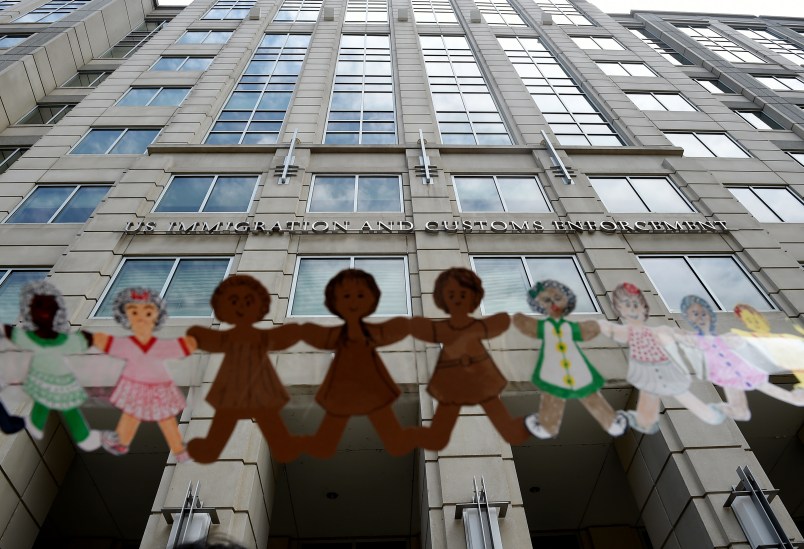This article first appeared at ProPublica. ProPublica is a Pulitzer Prize-winning investigative newsroom. Sign up for The Big Story newsletter to receive stories like this one in your inbox.
Since March, the Trump administration has pushed thousands of migrant children back to their home countries without legal screenings or protection, citing the risk that they could be carrying COVID-19 into the United States.
But by the time the children are boarded on planes home, they’ve already been tested for the virus — and proven not to have it.
Court documents, and information given by Immigration and Customs Enforcement to congressional staff last week, reveal that the Trump administration has agreed to test every child in its custody before sending them back to their home countries under the expulsion policy.
ICE’s comprehensive testing appears to undermine the rationale for the mass expulsion policy: that it is necessary to “prevent the introduction” of COVID-19 into the United States.
The Trump administration has argued that, because of the pandemic, it must circumvent protections built into immigration law for migrant children, which dictate they should be turned over to the Department of Health and Human Services (and ultimately to sponsors in the U.S.) and given a chance to seek asylum. Administration officials have said that they can’t risk that infected children would spread COVID-19 through the system. Yet even after children test negative for the virus, they aren’t being allowed to access the usual protections.
The Trump administration has cited sections 265 and 268 of Title 42 of the U.S. Code, which allows the Centers for Disease Control and Prevention to order the exclusion of any person or thing that might introduce a disease into the United States. Citing that law, in March the CDC began barring the entry of anyone crossing into the U.S. without papers.
“The Trump administration’s claim that they need to summarily expel children because of COVID was always a pretext,” Lee Gelernt of the ACLU, who has represented children in lawsuits challenging the expulsion policy, told ProPublica. “If they are now actually testing and know the children do not have COVID, then the policy is that much more unjustified.”
A court report filed in July noted that “virtually all” children in ICE custody were being tested for COVID-19 before expulsion, as a condition of “testing requirements” imposed by their home countries. In congressional briefings last week, recounted to ProPublica by multiple staff members who attended, ICE clarified what those “testing requirements” were.
The U.S. has agreements with 10 countries in Latin America and the Caribbean to return unaccompanied children under the public health order. All those agreements, ICE told Congress, require that children test negative for COVID-19 before being sent back.
“All single minors expelled from the U.S. under Title 42 authority are done so under informal agreements which remain fluid between the U.S. and the foreign governments,” an ICE spokesperson told ProPublica. “There are informal agreements in place with some countries which require testing for COVID-19 prior to expulsion.” Asked specifically about its claim to Congress that all countries agreeing to accept children required testing, and whether that was at odds with the stated rationale for the expulsion policy, ICE declined to clarify, citing “pending litigation.”
Under the new policy, most adult migrants are being pushed back to Mexico within a matter of hours. To apply the expulsion order to children, however, the administration has developed an ad hoc system in which children are held for days in hotels, with little contact with the outside world — making it almost impossible for lawyers or advocates to locate them — before being returned to the countries from which they fled.
Thousands of children have been expelled since the policy was enacted in March. Some are sent to overcrowded government shelters in Central American countries like Guatemala; others are totally out of reach of legal service providers, who have not been able to find them.
Under U.S. immigration law, unaccompanied migrant children who arrive without papers are supposed to be put in the custody of HHS, which can place them with a sponsor (usually a relative) while they await a hearing before a judge to determine if they qualify for immigration status. The Trump administration has claimed that it’s too dangerous to continue sending these children to HHS during a pandemic.
Acting Commissioner of Customs and Border Protection Mark Morgan argued during an Aug. 6 press briefing that “if we introduce these individuals to ORR” — the Office of Refugee Resettlement, which is the HHS office responsible for migrant children — “we’re defeating the entire purpose of Title 42, we’re still introducing these individuals into our system throughout and creating a greater exposure risk to the American people.”
But on July 22, an independent court report filed in the Flores litigation, which governs the care of children in immigration custody, noted that “virtually all individuals in hotels awaiting ICE deportation flights will be tested for COVID-19 prior to deportation to comply with testing requirements imposed by the home countries for returning deportees.” (The Trump administration stresses that “deportation” is a term from immigration law, and that, since migrants subject to the CDC order aren’t being processed under immigration law, what’s happening to them isn’t technically deportation. However, the court report used the term “deportation” to refer to public-health expulsions as well.)
In most cases, ICE is satisfying this requirement by using rapid COVID-19 tests produced by Abbott Laboratories that can produce results in as little as 15 minutes. While Abbott’s rapid tests have come under scrutiny for a high rate of false-negative results, they continue to be used by the Trump administration. However, at least one country — Guatemala — requires that the U.S. government obtain COVID-19 test results from a lab, a process that can take four to five days.
It is not clear exactly when the testing requirements went into effect. The court report refers to them as “recently imposed.” A Guatemalan official recently told Reuters that only a few of the children who have been returned to Guatemala under the policy have documentation proving they’ve tested negative for COVID-19. It’s not clear whether this means ICE is violating the terms of its agreement with Guatemala to test children, or if these children weren’t subject to that agreement. Anaeli Torres of Guatemala’s social welfare agency told ProPublica that it isn’t always known to the agency whether a child has been deported under immigration law or expelled under the public health order when they arrive in Guatemala from the U.S.
Since the spring, ICE has been accused of helping spread COVID-19 through Central America and the Caribbean by deporting people who had caught the coronavirus in immigration detention facilities. ICE has denied this, asserting that all detainees are tested for COVID-19 before being deported.
But people expelled under the public health law are not being put in ICE detention. Further, unlike deportees who are removed from the U.S. because they are found to have violated immigration law, migrants expelled under the public health policy have had no legal due process. They are being barred from the U.S. purely because they might have the coronavirus and might spread it to others.
The CDC’s original order banning the “introduction” of migrants, from March, assumed that it would be impossible to test migrants for COVID-19. That was key to its rationale for barring their entry. “In theory, to mitigate public health risks, CBP would have to transport aliens in their custody suspected of COVID-19 infection to a nearby medical site for sample collection and testing, and then implement containment protocols (i.e. quarantine or isolation) in their facilities while awaiting test results,” the order said. “CDC would not have the resources or personnel required to house in quarantine or isolation or monitor dozens, much less hundreds or thousands of aliens.”
In the months since, however, ICE has created an ad hoc system of quarantine and isolation. Migrants held in hotels, often for several days or even weeks, are prevented from leaving their rooms and have limited outside contact.
Ironically, migrants who test positive for COVID-19 are required to remain in the U.S., while those who test negative are expelled. It’s not clear if any unaccompanied children have tested positive for coronavirus while in ICE custody. At least one migrant family housed in a San Antonio hotel tested positive while awaiting expulsion. The family was sent to an ICE detention center to recover.
While referrals to HHS are supposed to happen within 72 hours, the administration has frequently held children in hotels for longer than that when preparing to expel them. The court report noted that testing requirements often prolonged their stays in the U.S. since results can take several days to process.
Rapid testing eliminates that concern, but ICE did not explain in its congressional briefing, or at any other time, why it cannot send children to HHS once they have tested negative.
Filed under:



